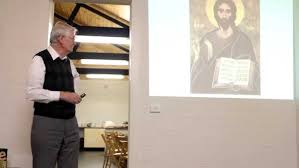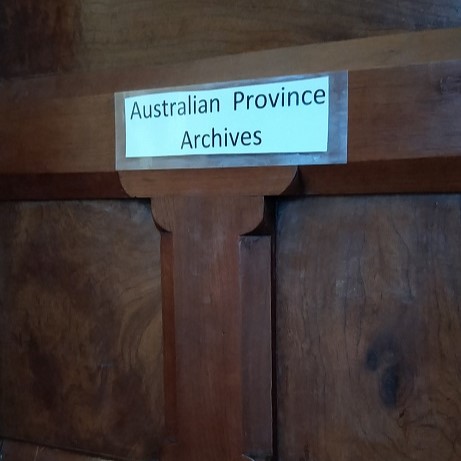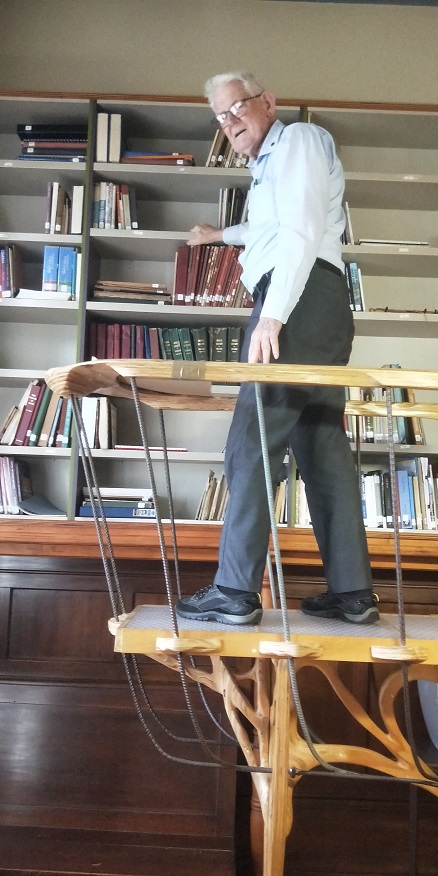A Tribute as we remember our confrere, Michael Fallon MSC

Last week, a requiem Mass for Michael was celebrated at Holy Rosary Church, Kensington. Relatives, as well as friends from the UNSW Chaplaincy days, shared memories. He was then buried at St Mary’s Towers, Douglas Park.
By way of tribute, here is the entry for Michael in the Annotated Bibliography of the Province, one of the largest. His last book was published at the end of 2024, Jesus’ Belief in God.
This entry is not for total reading, but an indication of Michael’s vast writing ministry. - and some photos from our archives.

FALLON, Michael (1937 – 2025)
The principal source for information on the work by Michael Fallon is his website. The website contains descriptions of all his books. It also has an extensive list of CDs as well as audio of lectures which can be downloaded for listening. Go to mbfallon.com
AT HOME WITH GOD, A Catholic View of Life.
Chevalier Press, Kensington, 1977, pp. 148.
An introduction to a Catholic view of World Religions, the Bible, Jesus, Theological Virtues, the Sacraments.
THE FOUR GOSPELS: an introductory commentary.
Catholic Adult Education Centre, Sydney, 1980, pp. 465.
THE WINSTON COMMENTARY ON THE GOSPELS,
Wiinston Press, 1980, (US edition of The Four Gospels)
THE OLD TESTAMENT: AN INTRODUCTION TO WRITINGS SACRED TO JEWS AND CHRISTIANS.
Chevalier Press, Kensington NSW. 2014, Pp. 221.
THE BOOK OF GENESIS
Chevalier Press, Kensington, NSW.2008, Pp.246.
UNDERSTANDING the kind of literature that we find in the Book of Genesis is fundamental to how we read this inspired work. This is especially important today because of the insistence of many who think that truth in the inspired word requires that it make only statements of fact, as though God could not inspire poetry, drama and saga. They resist the findings of scientific inquiry, both literary and archaeological. In doing so they misinterpret Scripture, and fail to appreciate the wonderful richness of this literature. (Michael Fallon’s own description.)
A PRIESTLY KINGDOM AND A HOLY NATION
Chevalier Press, Kensington, NSW. 2008, pp. 441.
EXODUS tells the story of God’s action in freeing a group of slaves from forced labour in Egypt, and leading them to Mount Sinai. Numbers completes the journey from Sinai to within sight of the Jordan River and the Promised Land. Between Exodus and Numbers is Leviticus. It lists the cult and other laws that had developed over the centuries and portrays them as having been commanded by God to Moses on the holy mountain. At one level Moses is centre stage, but the focus is on the wonderful Providence that brought these escaped slaves to a new idea of God as the God, not of the powerful, but of the poor, the weak, the widow and the orphan. The God of Moses, the God of the people of Israel, is a God who hears the cry of the poor. (Michael Fallon’s own description.)

THE BOOKS OF DEUTERONOMY, JOSHUA AND JUDGES
Chevalier Press, Kensington, NSW. 2008, Pp. 355.
DEUTERONOMY is a presentation of the essence of the religion of Israel. It reads as the final exhortation of Moses to the people before he hands over command to Joshua and dies on Mount Nebo, having seen but not entered the Promised Land. Deuteronomy refers back to the events that are recorded in Exodus and Numbers. Presented as it is as a long exhortation it highlight the fact that Bible texts were written to be proclaimed when the people assembled for worship. It was composed to encourage the people to remember their past and to be faithful to God who had chosen them as his own. It invites them (and through them us)
to see the continuing activity of God in each new generation. (Michael Fallon’s own description.)
THE PSALMS
Chevalier Press, Kensington, and NSW. 2005, Pp. 512
Writing in Alexandria in the fourth century, Saint Athanasius has this to say: 'The BOOK OF PSALMS is like a garden which contains the fruits of all the other books, grows a crop of song and so adds its own special fruit to the rest. It seems to me that for the person who recites them the psalms are like a mirror in which we may see ourselves and the movements of our heart and mind and then give voice to them. (Michael Fallon’s own description.)
ISRAEL’S 8TH CENTURY PROPHETS [AMOS, HOSEA, ISAIAH, MICAH]
Chevalier Press, Kensington, NSW. 2011, Pp. 233
The decades just before the middle of the eighth century BC were years in which Israel and Judah experienced relative peace and prosperity. Sadly, along with this went injustice. All four of our prophets speak out against this. The second half of the century witnessed the aggressive expansion of Assyria first into Israel and then into Judah. Hosea, Isaiah and Micah all had to deal with the effects of this expansion. Their guidance was ignored for the most part by their contemporaries. (Michael Fallon’s own description.)
ISRAEL’S 7TH CENTURY PROPHETS [ZEPHANIAH, NAHUM, HABAKKUK, JEREMIAH]
Chevalier Press, Kensington, NSW. 2011, Pp. 283
THE PROPHETS covered in this volume ministered in the eventful final three decades of the seventh century, decades which saw the ambitious attempts by King Josiah to restore the kingdom of David. The seventh century ended with the capture of Jerusalem and the exile of its king and leading citizens, tragedies echoed in the oracles of Habakkuk and Jeremiah. (Michael Fallon’s own description.)
ISRAEL’S 6th CENTURY PROPHETS [EZEKIEL, ISAIAH 40 - 66, HAGGAI AND ZECHARIAH]
Chevalier Press, Kensington, NSW. 2011, Pp. 353
EZEKIEL and the Isaiah School responsible for Isaiah 40-55 wrote from exile in Babylon. Haggai, Zechariah and the Isaiah School responsible for Isaiah 56-66 wrote from Judah in the years after the return from exile. (Michael Fallon’s own description.)

ISRAEL’S 5TH CENTURY PROPHETS [OBADIAH, ZECHARIAH, JOEL, MALACHI, JONAH] AND DANIEL.
Chevalier Press, Kensington, NSW. 2011, Pp. 167
THE AIM of this Introductory Commentary is to attempt to discover and express what it was that the prophets of fifth century Israel (and second century Daniel) intended to say by their words, how their contemporaries understood them, and why people cherished, preserved, copied, edited and handed on their words. This is harder to do for fifth century Judah than for earlier centuries because of the poverty of the historical record, and because the prophets, living under Persian domination, were less interested in history
than in their hope of divine intervention. (Michael Fallon’s own description.)
THE ISAIAH SCROLL
Chevalier Press, Kensington, NSW. 2009, Pp. 271
THE BOOK OF ISAIAH covers over three hundred years of Judah's history, and reflects on the presence and action of YHWH in that history, including the years that led up to the Fall of Jerusalem, the traumatic years of exile in Babylon, and the difficult years after the exile, in which the he School of Isaiah struggled for the soul of Judah. (Michael Fallon’s own description.)
THE FESTIVAL SCROLLS [THE SONG OF SONGS, THE BOOK OF RUTH, LAMENTATIONS, ECCLESIASTES, ESTHER]
Chevalier Press, Kensington, NSW. 2011, Pp. 216
THESE SCROLLS were preserved in the hope that later generations, through prayerful reflection, would come to know God and how we are to live so as to welcome God's blessings. The continued use of these scrolls by the Jewish community in the various festivals that are part of their liturgical calendar is witness enough to the value attached to them. (Michael Fallon’s own description.)
THE BOOK OF PROVERBS, THE BOOK OF JOB
Chevalier Press, Kensington, NSW. 2011, Pp. 228
THE BOOK OF PROVERBS is a collection of the oldest wisdom sayings of Ancient Israel. It includes instructions and suggestions on how to live a productive and fulfilled life. The 'wise sayings' are the fruit of reflection on life experience and on Israel's faith. The BOOK OF JOB, acknowledged as a poetic masterpiece, examines human suffering, and in doing so challenges traditional 'wisdom'. (Michael Fallon’s own description.)

FIRST & SECOND SAMUEL. FIRST CHRONICLES
Chevalier Press, Kensington, NSW. 2012, Pp. 211
The Books of Samuel tell the story of the beginnings of the monarchy in Israel, first King Saul and then King David. The stories speak of what the nation and its leaders are called to be. Hence the central role of the prophet Samuel and the inclusion of these writings among the Prophetic Scrolls. Writing some centuries after the Books of Samuel, the author of First Chronicles revisits the story of King David, portraying him as the ideal king, and tracing back to him the religious practices that were current in the Judaism of the fourth century BC. (Michael Fallon’s own description.)
FIRST & SECOND KINGS. SECOND CHRONICLES
Chevalier Press, Kensington, 2012, NSW.
The Books of Kings tell the story of King Solomon and the kings of Israel and Judah down to the destruction of Jerusalem in 587BC. The aim of the authors was not to repeat the history, but to offer an interpretive commentary, focusing on the way they understood God to have been present and active in their past. Hence the central role of the prophets. Hence the inclusion of these writings among the Prophetic Scrolls. The author of Second Chronicles revisits the story of the kings of Judah tracing the history of the religious practices that were current in the Judaism of the fourth century BC. (Michael Fallon’s own description.)
THE BOOKS OF EZRA & NEHEMIAH
Chevalier Press, Kensington, NSW. 2012, Pp. 84
The Book of Ezra tells the story of the return of the exiles from Babylon to Judah, and the re-building of the temple. Drawing on the memoirs of Ezra, it goes on to record his arrival in Judah in 458BC and his work in reforming the life of the community according to the law, which he brought with him from Babylon. Tradition looks on him as a second Moses, who established the foundations of post-exilic Judaism. The Book of Nehemiah draws on Nehemiah’s memoirs to tell the story of his period as governor of Judah, firstly from 445-433BC, and then for a second term some years later. It was he who saw to the rebuilding of the walls of Jerusalem. (Michael Fallon’s own description.)
FIRST & SECOND MACCABEES
Chevalier Press, Kensington, NSW. 2012, Pp. 186
These two very different books tell the story of the successful struggle of the Jews to hold on to their faith and their religious traditions against the overwhelming pressure to be part of the Hellenistic culture that threatened to swamp them in the second century BC. I Maccabees highlights the heroic resistance of the priest Mattathias, and the brilliant and finally successful guerrilla campaign led by his sons Judas, Jonathan and Simon. II Maccabees was written a decade later.
It recognizes the providential significance of Judas Maccabaeus (after whom the books are named), but the author’s focus is on God, not on the Hasmonaean dynasty of which he clearly disapproves. (Michael Fallon’s own description.)

TOBIT AND JUDITH
Chevalier Press, Kensington, NSW. 2012, Pp. 113
Tobit is a short story, a romance. The author, writing somewhere in the East, and probably in the third century BC, wants his Jewish contemporaries to appreciate the blessings of the covenant they have with their God, and the benefits that flow from a life lived in obedience to the Torah. The story has a lot to tell us about living a noble and just life, expressed in acts of kindness.
Judith, too, is a story, composed in Judah in the last decades of the second century BC. The heroine is a woman, Judith, who lives in an imaginary town in Samaria. She is victorious over the general of the most powerful army in the world. The author wants to encourage his contemporaries to persevere in their faith. Their situation may appear impossible, and their enemies invincible, but only God is invincible and God is committed to his people. They must never lose faith or abandon their traditional way of life in obedience to the Torah. (Michael Fallon’s own description.)
WISDOM OF BEN SIRA & WISDOM OF SOLOMON
Chevalier Press, Kensington, NSW. 2012, Pp. 272
As well as such inspiring passages as Chapter 24 (a hymn to Wisdom), Chapter 34:14-20 (on divine providence), Chapter 39:12-35 (in praise of the Creator), and the concluding hymn (51:13-30), we can find many gems of wisdom from Ben Sira, a remarkable teacher whose career in Jerusalem spanned the final decades of the third century BC, and continued into the early years of the second century.
There are times (but very few) where Christians reading this text can imagine Jesus saying: ‘It was said to you of old, but I say’. One obvious example is Chapter 12:1-7, where the author assumes that God hates sinners, and encourages his students to do the same. He speaks quite beautifully about forgiveness, but it does not extend to one’s enemies. He displays a special antipathy to the Samaritans. He encourages a caring attitude to those in need, but his attitude to women witnesses to the prevailing assumption that they are inferior to men. However, all in all, Ben Sira offers much practical and wise advice, as relevant in our day as it was in his.
The author of the Wisdom of Solomon composed his work two centuries later, in Alexandria, during the Roman period. He draws on the same Jewish tradition, but he also draws on current Hellenistic philosophy with which he was very familiar. He writes in Greek, and when he covers themes found also in Sirach he uses the language, not of the Septuagint, but of the Hellenist schools. He wants his students to engage with Hellenism, but to value the special wisdom that is their patrimony as Jews. (Michael Fallon’s own description.)
THE GOSPEL OF ST MATTHEW
Chevalier Press, Kensington, NSW. 1997, Pp.395
It is the Spirit of Jesus who continues to use MATTHEW'S text to draw us into a deeper understanding of and love for God, revealed so beautifully in Matthew's portraits of Jesus. Matthew is also intensely interested in the Church, a community of faulty human beings in whose midst is the risen Jesus, who is constantly teaching, forgiving and drawing us into ever closer communion with one another as we strive to carry on his redemptive mission in the world. 395 pages $25 (Michael Fallon’s own description.)

THE GOSPEL OF ST MARK
Chevalier Press, Kensington, NSW. 1997, Pp. 293
MARK'S GOSPEL is very conscious of conflict. In this too he has a lot to teach us. Having lost his two mentors, Peter and Paul, in Nero's persecution in the middle sixties, Mark completed his gospel during the catastrophe of the Jewish-Roman war that broke out in 66AD. Many Christians must have been wondering about the reality of the salvation brought by Jesus. Similar questions face us today. (Michael Fallon’s own description.)
THE GOSPEL OF ST LUKE
Chevalier Press, Kensington, NSW. 1997, Pp 375
LUKE'S GOSPEL is intricately and delicately composed to highlight his main themes. He is especially interested in God's action in history, seen in the ministry of Jesus and carried forward in the ministry of the apostles and Paul. Luke is inviting his readers to examine their own religious experience and to discover, especially in their experience of God's forgiveness, and in their endurance as disciples, the action of God's Holy Spirit binding them to Jesus and enabling them to persevere as Jesus' disciples, continuing his mission in the world. (Michael Fallon’s own description.)
THE GOSPEL OF ST JOHN
Chevalier Press, Kensington, NSW, 1998, pp. 386
Our earliest systematic commentary on JOHN'S GOSPEL comes from Origen, writing in Alexandria c.230AD. He states: 'We might dare to say that the Gospels are the first fruits of all Scriptures, but that the first fruits of the Gospels is that according to John, whose meaning no one can understand who has not lain on Jesus' breast nor received Mary from Jesus to be his mother also. However, he who would be another John must become like John ... For indeed everyone who has been perfected "no longer lives, but Christ lives in him" (Galatians 2:20), and since Christ lives in him it is said of him to Mary "Behold your son". (Michael Fallon’s own description.)
THE ACTS OF THE APOSTLES
Chevalier Press, Kensington, NSW, 2003, Pp.264.
The more we know of the first century Hellenistic world the better does Luke appear as a historian. Upon close examination claimed discrepancies between ACTS and what we know of Paul from Paul's own letters disappear and Luke's work is revealed as a rich resource for our understanding of Paul from one of Paul's collaborators. At the same time it is important to realise that the centre of attention is not Paul or any other apostle. Luke never allows our attention to stray from gazing with
wonder at what the Spirit of the risen Christ is doing in the world to continue Jesus' mission of revealing God as a God of love who is constantly drawing people together, whatever their racial identity, into a community of love. (Michael Fallon’s own description.)

ST PAUL: NEW TESTAMENT LETTERS VOLUME 1
Chevalier Press, Kensington, NSW, 2004, Pp.769.
The author writes: 'In some ways this commentary has been my life's work. I was first impressed by the breadth of Paul's thought during my studies in the seminary during the 50's. I was especially moved by the obvious love of the man and by the courage with which he carried out his mission of taking the best of the faith of Abraham and Moses – the faith as lived by Jesus – to the Gentile world. I found the universality of his thought inspiring and wonderfully relevant to our times, for we know that if 'salvation' means anything it must concern the human race, and not a special privileged group'. (Michael Fallon’s own description.)
STS JAMES, PETER, JOHN, JUDE, AND HEBREWS: NEW TESTAMENT LETTERS VOLUME 2
Chevalier Press, Kensington, NSW, 2004, pp.291
These marvellous LETTERS give us an insight into the wealth, depth and variety of the ways in which the Christian communities of the first century thought of Jesus, of the God of love whom he revealed, and of what it means to live as a disciple of Jesus, open to the grace of God's Spirit. (Michael Fallon’s own description.)
THE APOCALYPSE
Chevalier Press, Kensington, NSW, 2002, pp. 131
The Apocalypse is a dramatic and richly symbolic manifesto of the ultimate victory of love, of the values of Christ over against the oppression of the Roman state at the close of the first century. Modern attempts to identify today's events in its pages are misguided, for the aim of its author was to help his contemporaries see the events of their own day in the light of faith, not to offer them tantalising images of future events which could have no relevance for them. (Michael Fallon’s own description.)
WHO IS JESUS?
Parish Ministry Publications, Sydney, 1987.
'Who is Jesus? - exploring the responses of the first Christian communities and the early Church councils. I
A PRIEST AFTER MY OWN HEART: EXPLORING PRIESTLY SPIRITUALITY
St Paul’s Publications, 2001 pp. 172.
This book is available only on Michael's website: mbfallon.com 'I will raise up for myself a faithful priest who shall act according to what is in my heart.' (1 Samuel 2:35). After reflecting on the sacramental consecration of the priest to Christ, and the role of the priest in the mission of the Church, this book focuses on the special holiness of one who is called to give his life in and for the world. It looks at different aspects of the mediatory role of the priest and the place of suffering in a priest's life and ministry. It concludes with a reflection on consecrated celibacy as the way of loving that the Church asks of priests.

YIELDING TO LOVE: LEARNING TO FOLLOW OUR YEARNING FOR DEEPER COMMUNION WITH GOD
St Paul’s Publications, 2005 pp. 206
The adventure of prayer is a journey over a lifetime with many twists and turning, plus the occasional crisis. Nobody else can make that journey for us. Nor can we see clearly what shape our future relationship with God will take … This is where we can learn from those who have made the same journey as ourselves … Father Fallon is especially indebted to two great Carmelite saints, Teresa of Jesus and John of the Cross, but he presents their teaching in a way that reflects his years of study in the field of biblical exegesis, and his pastoral dealings with many ordinary Christians This is a book that will repay loving attention. I recommend it to all who seek to deepen their prayer and through it to grow in love for God and neighbour' (from the Foreword by Michael Casy OCSO).
A COMPANION TO THE CATECHISM OF THE CATHOLIC CHURCH
Chevalier Press, Kensington, NSW, 2013, pp. 415.
In introducing the Catechism, Pope John-Paul II declared: ‘it is meant to encourage and assist in the writing of new local catechisms, which take into account various situations and cultures, while carefully preserving the unity of faith and fidelity to Catholic doctrine’. What I am offering is not a catechism, but it in my prayer that you, the reader, will indeed find this book a true companion, as you delve into the rich resource which the Catholic Church has offered us in the Catechism. (Michael Fallon’s own description.)

THE QURAN FROM A NEW TESTAMENT PERSPECTIVE
Available from website, Michael Fallon, 2017, pp. 80.
The Quran from a New Testament perspective
The Quran and the Jewish Scriptures
The Christian New Testament and the Muslim Quran
Part One
Muhammad and the Quran
God
God’s revelation and religious texts
Obeying a non-Muslim government
Relations between man and woman
The fate of disbelievers
Misunderstanding Christian teaching
Divine authorisation of the use of force
Muhammad and the Christian Scriptures
Monotheism
The Divinity of Jesus and Christian teaching of the Trinity
Our destiny
Care for the poor
Part Two
Sûrahs 1 – 114
PRAYING THE PSALMS WITH JESUS
Chevalier Press, Kensington, NSW. 2018. Pp. 450
In 2005 I published The Psalms: an introductory commentary (Chevalier Press). Assisted by the nearly two thousand page commentary by Luis Alonso Schökel SJ (in Italian I Salmi, Editioni Borla, 1992), my aim was to discover and share the meaning that the psalms had for those who composed them and for those who prayed them in Ancient Israel, whether in the temple cult or in their own personal and family prayer.
My aim here is different. I want to explore how Jesus would have prayed the psalms, based on what we know of his mind and heart from the New Testament. Necessarily this will involve an editing of the psalms, for there are sentiments in some of them that contradict what Jesus knew of God and of the kind of communion with God that we are invited to enjoy. After presenting a translation of a psalm that I hope Christians, in communion with Jesus, can pray today, I indicate any verses that I have omitted, and then go on to meditate on the psalm, praying it with Jesus. (Michael Fallon’s own description.)
JESUS AS PORTRAYED IN THE NEW TESTAMENT. DIVINE LOVE IN A HUMAN HEART
Coventry Press, Bayswater, Vic, 2020, pp. 214.
But who do you say that I am? (Matthew 16:15). Jesus' question to Peter and the others is one that every disciple needs to consider, a question that is as old as the Christian tradition. And behind the question an even deeper and challenging one: Who is God?
Michael Fallon argues that the response to both questions must be informed by how we read the New Testament. There, we find the portrait of a man who lived and died in our world, a human being like ourselves, someone recognised by his followers as free from the fear of God or other people - someone who taught us to respond to the divine, someone in whom they acknowledged the human expression (Coventry Press).
SHARING JESUS’ BELIEF IN GOD
Coventry Press, Bayswater, Vic, 2024, pp. 80
Further explorations of the person of Jesus.
